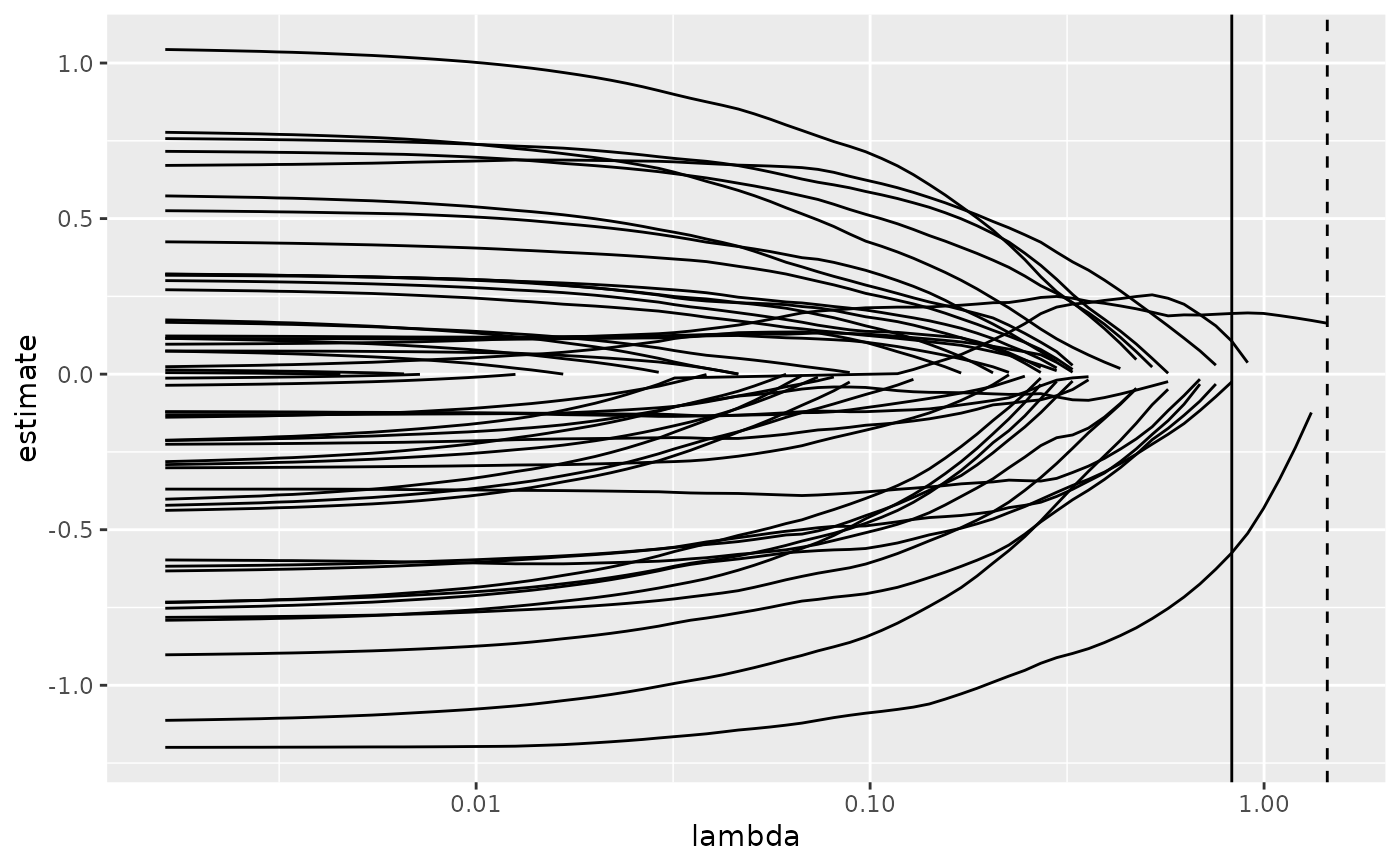Glance accepts a model object and returns a tibble::tibble()
with exactly one row of model summaries. The summaries are typically
goodness of fit measures, p-values for hypothesis tests on residuals,
or model convergence information.
Glance never returns information from the original call to the modeling function. This includes the name of the modeling function or any arguments passed to the modeling function.
Glance does not calculate summary measures. Rather, it farms out these
computations to appropriate methods and gathers the results together.
Sometimes a goodness of fit measure will be undefined. In these cases
the measure will be reported as NA.
Glance returns the same number of columns regardless of whether the
model matrix is rank-deficient or not. If so, entries in columns
that no longer have a well-defined value are filled in with an NA
of the appropriate type.
Usage
# S3 method for class 'cv.glmnet'
glance(x, ...)Arguments
- x
A
cv.glmnetobject returned fromglmnet::cv.glmnet().- ...
Additional arguments. Not used. Needed to match generic signature only. Cautionary note: Misspelled arguments will be absorbed in
..., where they will be ignored. If the misspelled argument has a default value, the default value will be used. For example, if you passconf.lvel = 0.9, all computation will proceed usingconf.level = 0.95. Two exceptions here are:
See also
Other glmnet tidiers:
glance.glmnet(),
tidy.cv.glmnet(),
tidy.glmnet()
Value
A tibble::tibble() with exactly one row and columns:
- lambda.1se
The value of the penalization parameter lambda that results in the sparsest model while remaining within one standard error of the minimum loss.
- lambda.min
The value of the penalization parameter lambda that achieved minimum loss as estimated by cross validation.
- nobs
Number of observations used.
Examples
# load libraries for models and data
library(glmnet)
#> Loaded glmnet 4.1-10
set.seed(27)
nobs <- 100
nvar <- 50
real <- 5
x <- matrix(rnorm(nobs * nvar), nobs, nvar)
beta <- c(rnorm(real, 0, 1), rep(0, nvar - real))
y <- c(t(beta) %*% t(x)) + rnorm(nvar, sd = 3)
cvfit1 <- cv.glmnet(x, y)
tidy(cvfit1)
#> # A tibble: 74 × 6
#> lambda estimate std.error conf.low conf.high nzero
#> <dbl> <dbl> <dbl> <dbl> <dbl> <int>
#> 1 1.45 17.4 2.28 15.1 19.7 0
#> 2 1.32 17.4 2.28 15.1 19.7 1
#> 3 1.20 17.2 2.22 15.0 19.5 1
#> 4 1.09 17.0 2.15 14.8 19.1 1
#> 5 0.997 16.8 2.09 14.7 18.9 1
#> 6 0.909 16.7 2.03 14.7 18.7 2
#> 7 0.828 16.7 1.99 14.7 18.6 3
#> 8 0.754 16.7 1.95 14.7 18.6 5
#> 9 0.687 16.8 1.93 14.8 18.7 7
#> 10 0.626 16.9 1.91 15.0 18.8 7
#> # ℹ 64 more rows
glance(cvfit1)
#> # A tibble: 1 × 3
#> lambda.min lambda.1se nobs
#> <dbl> <dbl> <int>
#> 1 0.828 1.45 100
library(ggplot2)
tidied_cv <- tidy(cvfit1)
glance_cv <- glance(cvfit1)
# plot of MSE as a function of lambda
g <- ggplot(tidied_cv, aes(lambda, estimate)) +
geom_line() +
scale_x_log10()
g
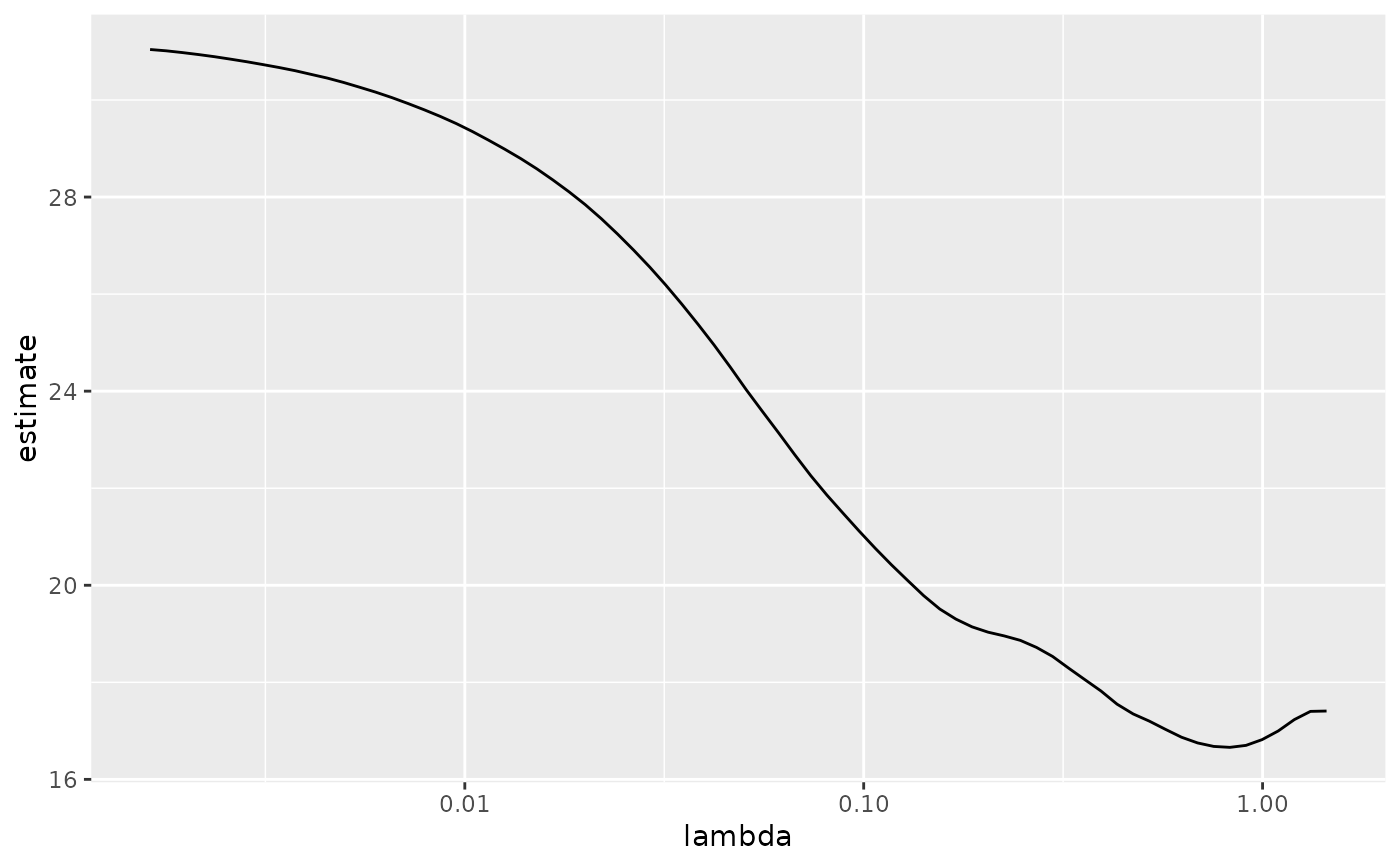 # plot of MSE as a function of lambda with confidence ribbon
g <- g + geom_ribbon(aes(ymin = conf.low, ymax = conf.high), alpha = .25)
g
# plot of MSE as a function of lambda with confidence ribbon
g <- g + geom_ribbon(aes(ymin = conf.low, ymax = conf.high), alpha = .25)
g
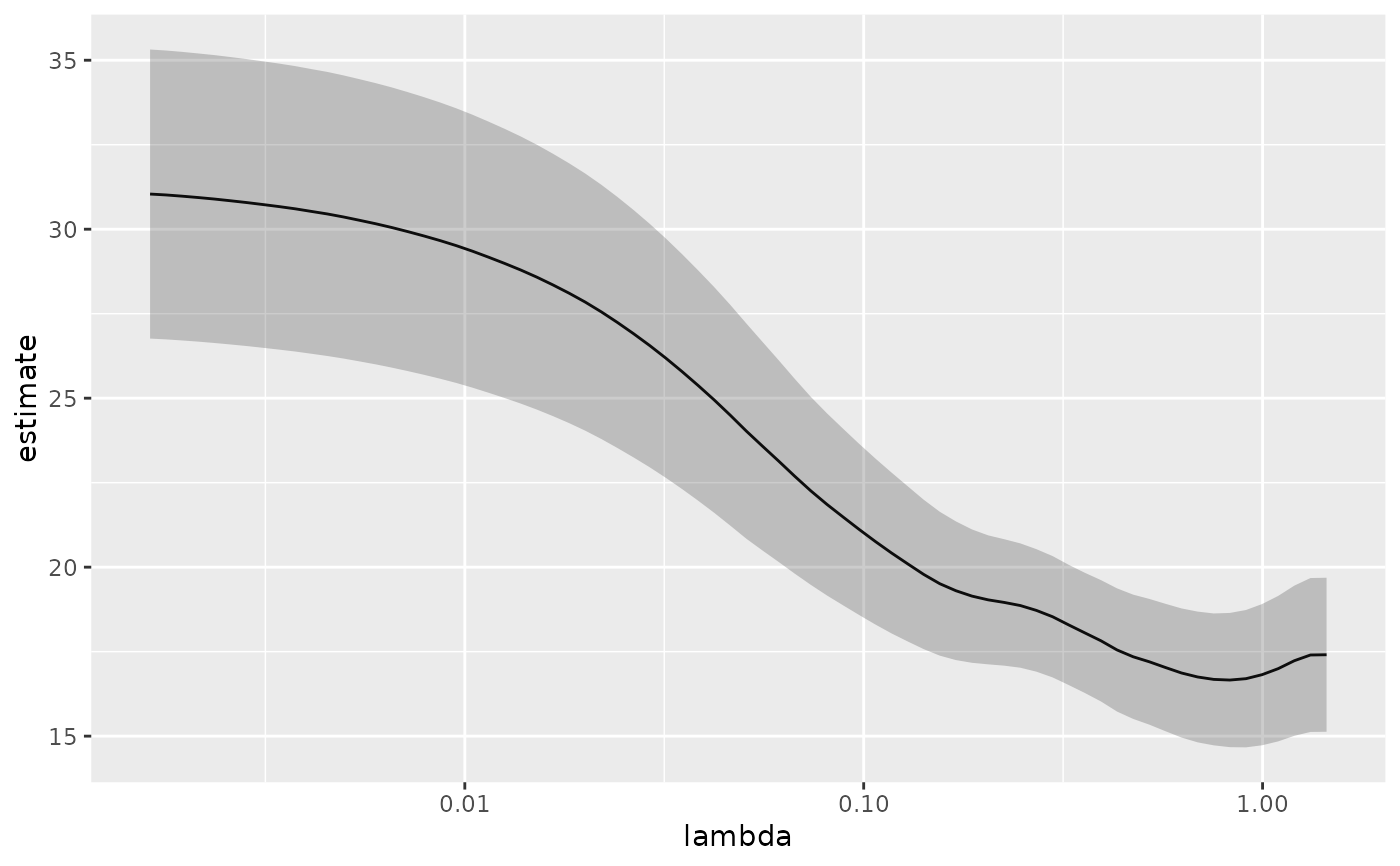 # plot of MSE as a function of lambda with confidence ribbon and choices
# of minimum lambda marked
g <- g +
geom_vline(xintercept = glance_cv$lambda.min) +
geom_vline(xintercept = glance_cv$lambda.1se, lty = 2)
g
# plot of MSE as a function of lambda with confidence ribbon and choices
# of minimum lambda marked
g <- g +
geom_vline(xintercept = glance_cv$lambda.min) +
geom_vline(xintercept = glance_cv$lambda.1se, lty = 2)
g
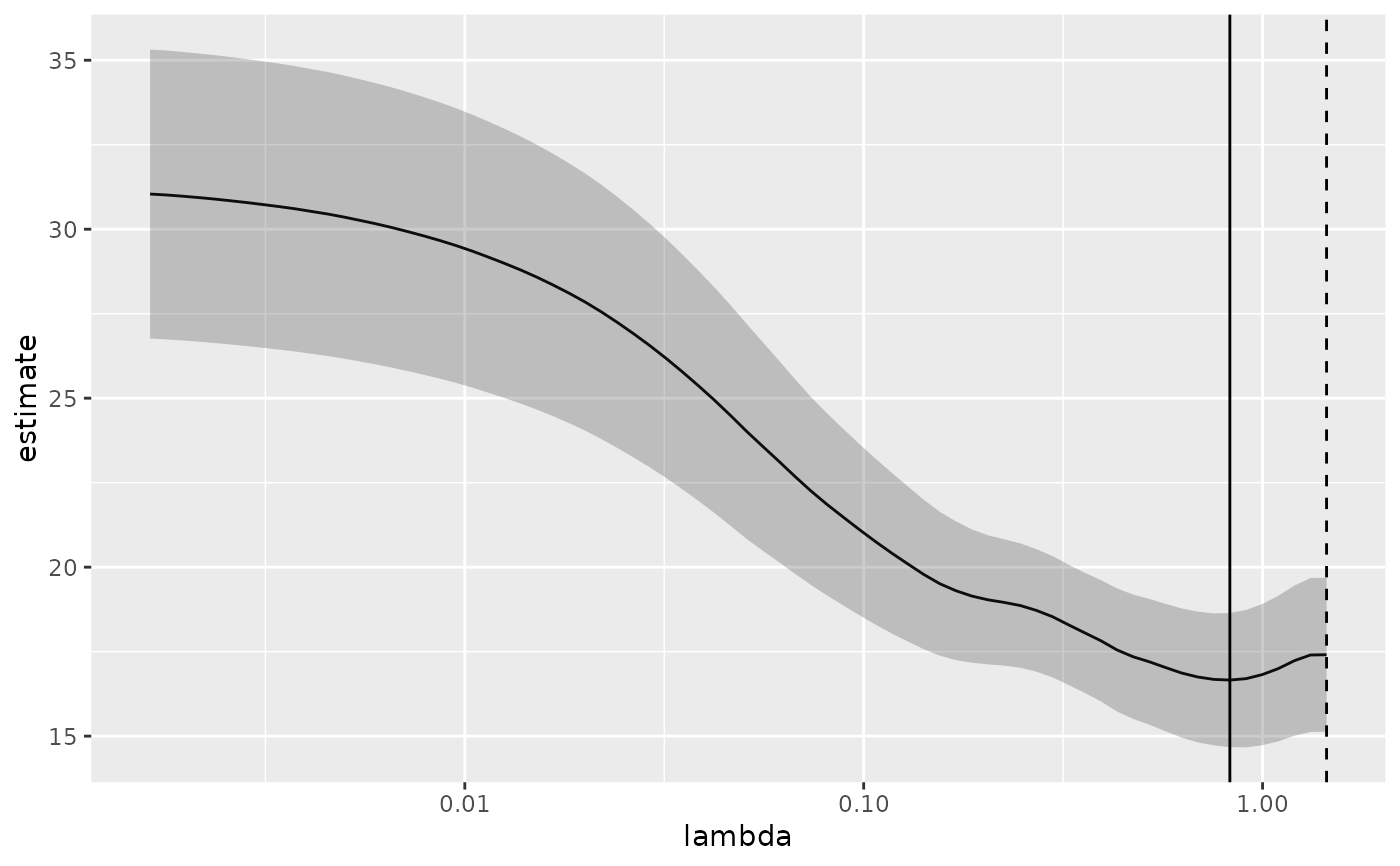 # plot of number of zeros for each choice of lambda
ggplot(tidied_cv, aes(lambda, nzero)) +
geom_line() +
scale_x_log10()
# plot of number of zeros for each choice of lambda
ggplot(tidied_cv, aes(lambda, nzero)) +
geom_line() +
scale_x_log10()
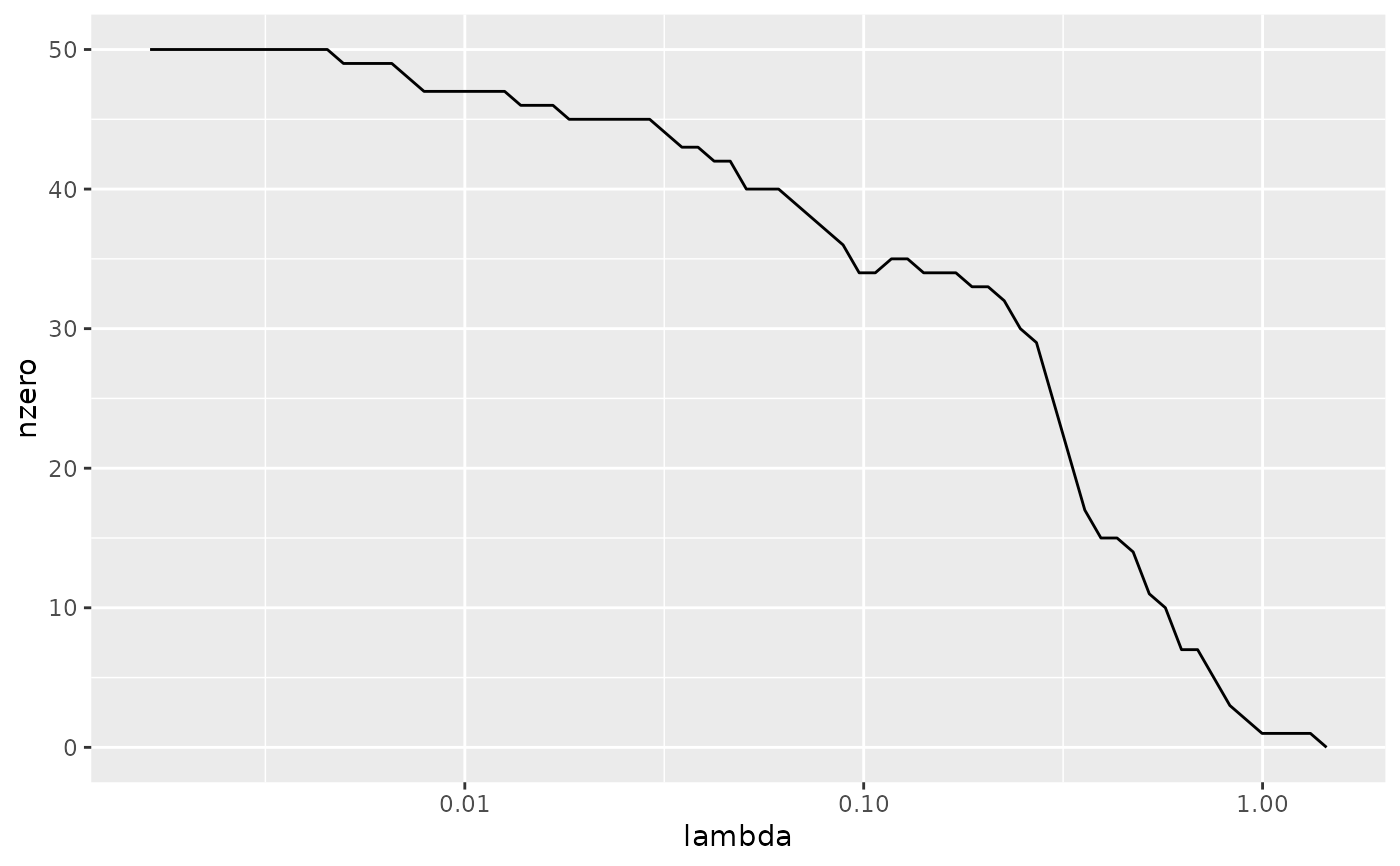 # coefficient plot with min lambda shown
tidied <- tidy(cvfit1$glmnet.fit)
ggplot(tidied, aes(lambda, estimate, group = term)) +
scale_x_log10() +
geom_line() +
geom_vline(xintercept = glance_cv$lambda.min) +
geom_vline(xintercept = glance_cv$lambda.1se, lty = 2)
# coefficient plot with min lambda shown
tidied <- tidy(cvfit1$glmnet.fit)
ggplot(tidied, aes(lambda, estimate, group = term)) +
scale_x_log10() +
geom_line() +
geom_vline(xintercept = glance_cv$lambda.min) +
geom_vline(xintercept = glance_cv$lambda.1se, lty = 2)
